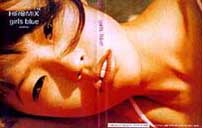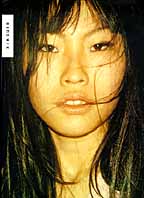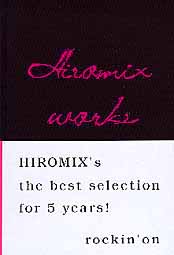HIROMIX: Difference between revisions
No edit summary |
(No difference)
|
Revision as of 08:14, 29 February 2008
 Hiromix ヒロミックス (1976.9.24- ) Tokyo. Real name Toshikawa Hiromi (利川 裕美).
Hiromix ヒロミックス (1976.9.24- ) Tokyo. Real name Toshikawa Hiromi (利川 裕美).
Since the mid-1990s, one of the most well-known and sensational young female photographers in Japan.
Major themes Self-portraits, photo diary, musicians, fashion models. Main influences (and mentors) were ARAKI Nobuyoshi and HOMMA Takashi.
Education Saginomiya High School, Tokyo, graduated 1995.
Career Father is a chef (French cuisine). Her first claim to fame was through a photo contest called the "11th New Cosmos of Photography (Shashin Shin-seiki, sponsored by Canon) in March 1995. Her entry was a small 36-page photo book made of color copies of regular prints. The title was Seventeen Girl Days (also called "School Days"). It was a photo diary compiled into an album-like booklet which was not an unusual technique.
However, her photos gave a light-hearted, fast-paced, and original look at this 17-year-old high school senior girl. It was a glimpse into the girl's everyday scenes and ordinary icons: a pet cat, a record, poster, flowers, friends, and self portraits. All the good, random moments of her current life.
She used a Konica "Big Mini" compact camera. (One of the first shots she took with that camera was of herself with her hand holding the camera outstretched in front of her.) Araki Nobuyoshi, one of the judges, nominated her as the contest's 1st place winner. She worked on the photo book while seeking the advice of Homma Takashi, a noted photographer. Her first photo book, girls blue, contained many photos from Seventeen Girl Days. It's perhaps her best book.
In 1995, the year of her high school graduation, she already embarked on a full-blown photography career. She wrote a diary for an Internet magazine, she photographed musicians for "Rockin' On Japan" magazine, she was commissioned to be the photographer for the J-Wave FM radio station posters for train stations, and in Dec. she was named the overall "Grand Prix" winner for the 11th New Cosmos of Photography photo contest, earning 1 million yen in prize money.
However, a week before the awards ceremony, the immense media frenzy and sudden fame had took its toll on her and she fell ill with stress-induced gastritis. Her mother accepted the award on her behalf. (This photo contest has since served as a major photography career springboard for many of the contest winners.)
With eye make-up on, Hiromix has quite an eye-catching face. (She has a trademark "mod" look reminiscent of the 1960s or '70s.) Her self-portraits of her petite body are also quite sexy with mini-skirts, hot pants, underwear, topless, etc. She had all the elements (youth, sex appeal, a fresh face, and talent) for mass media appeal and was soon featured in many major magazines and on TV programs.
Since junior high school, she liked the 1960s and '70s look. Where she grew up, there were many used clothing and recycle shops and browsing through old and cheap clothes was one of her favorite pasttimes. She went to flea markets as well and made friends, four of whom with which she formed a '60s-style R&B group called The Clovers. This group of five mod-looking girls emphasized their looks and style more than their lackluster singing.
She loves all kinds of colors in her photos. She has also tried her hand at movie-making (of an R&B event) and enjoyed what the medium can offer. Hiromix continues to be busy with editorial, advertising, and photo art work. Rockin' On Japan, a music magazine, is one publication where her photos appear regularly.
In 2000, she published Hiromix Works which was a retrospective collection of photos taken for music magazines in the past few years. The book won her the prestigious Kimura Ihee Award announced in spring 2001. (jointly with NAGASHIMA Yurie and NINAGAWA Mika).
She has also served as a judge in photo contests.
Awards Canon 11th New Cosmos of Photography, Araki Award and Grand Prix Winner 1995; Kodak Fotobuch Preis, 1998; 26th KIMURA Ihee Award, 2000. (2002.07.20)
girls blue
 Reviewed on Jan. 11, 1998
Reviewed on Jan. 11, 1998
HIROMIX the queen bee of the photo diary style, issues her first photo book for public consumption.
HIROMIX won a major photo contest in 1995 and found sudden fame for her nude self portraits and photo diary snapshots. Her spectacular success in such a short period of time is truly amazing. She has legitimized the photo diary style of photography which is nothing but a bunch of photos of oneself, friends, and everyday things. All of a sudden, other young girls started photographing the ordinary and mundane things in their lives or their nude bodies. The penchant for imitation is still alive and well in Japan. High school girls also got into the act by carrying and using single-use cameras for capturing whatever captures their fancy. The photos were just a bunch of snaps that any person on the street could take. There was nothing artistic about them. Japan's photography establishment didn't take the photo diary boom seriously at first (the same goes for Print Club). But they do now.
You just can't ignore a boom which translates into substantial profits for film and camera makers, photo finishers, and even pen (for drawing on the photos) manufacturers. The establishment has wised up and you can find cutsey-tutsey single-use cameras targeting high school girls, permanent-ink pens in all colors and sizes, and how-to books just for this market.
Anyway, getting back to girls blue, this is a book which shows the style that made HIROMIX famous. The book shows 122 color photos selected by HIROMIX from among the 30,000 pictures she had taken since age 17. The book's publishing was timed to coincide with her photo exhibition called "THE deep."
First of all, dig the book's cover. It covers both the front and back of the book. It folds out like a mini poster. The front side, as you see above, shows a close-up of her intriguing face resting sideways. But that's not all, on the under side of this book cover, you see a full-length shot of her topless. The petite body which helped her get famous. (But I think it was her exotic, slit-eyed face which did the trick of attracting so much attention.) You know, there are many Japanese teen idols whom I just cannot fathom why they got so popular. But in the case of HIROMIX, I can somehow understand why.
The book is just a collection of miscellaneous snapshots. A lot of young girls like herself are pictured (her friends and associates no doubt). Except for the book's mini-poster cover, there are no nudes. The photos are really random. You see buildings at night, a face of a girlfriend with a cigarette in her mouth, a bed of flowers, a bowl of soup, a girl having lunch, a man playing pinball, a cat walking on green grass, two girls crossing the street, a bunch of green apples, etc., etc. The pictures don't make any sense. And she admits that herself with a short blurb (written in both Japanese and English) at the end of the book: "Photography is the place where I can express all what I feel and think in everyday life. It would not be understood by grown-ups or kids--only we can see what it is. So, I don't expect everyone to understand it."
Fortunately, after every few pages of the potpourri of incomprehensible images, we see a picture of HIROMIX. This I can relate to and understand. It's a welcome relief from the haphazard sequence of images and our eyes and brains can take a break from all the confusion.
Yep, this photo diary thing is very personal and private, understood only by the photographer. So why show these photos in public to strangers? I once heard someone say that the more you don't understand it, the more it is art. So I guess if you're a true artist, you make things people don't understand. (Reviewed by Philbert Ono) Original book review here.
HIROMIX
 Reviewed on July 21, 1999
Reviewed on July 21, 1999
A book published by Steidl (Germany), very similar in concept as with her first photo book girls blue.
If you missed obtaining a copy of HIROMIX's first photo book, girls blue, then HIROMIX would give you a good idea of what you missed. Both books are almost identical in concept. HIROMIX contains random photos of everyday things, mainly food, flowers, pets, and friends (including actor Hiroyuki Ikeuchi and photographer Takashi Homma with blonde hair). There are also quite a few snapshots of her feet. It seems that HIROMIX is returning to her photographic roots with her latest photo book. It's what made her famous in Japan, and she apparently is prepared to ride that same wave again. This time to a different shore outside Japan with a German publisher.
As in girls blue, we see her self-portrait every few pages. She either takes a picture of her reflection in a mirror or she extends her arms out while pointing the camera at herself and clicking. A few self-portraits show her without make-up on, and she looks rather ordinary without it. Sometimes it looks like she took a picture of herself right after waking up in the morning.
So which book is better? I would have to say girls blue. For one thing, the girls blue cover photo is much more eye-catching than the cover photo on HIROMIX which makes her look like a fox (the animal). Also, HIROMIX has no nudes (there is one, but it's too dark to tell) unlike in girls blue where she gave us a memorable mini-poster of herself topless on the reverse side of the book's removable cover. Perhaps she's becoming more conservative. But as far as visual impact is concerned, girls blue has the edge. (Unfortunately, girls blue is out of print.) (Reviewed by Philbert Ono) Original book review here.
HIROMIX Works
 Reviewed on May 17, 2000
Reviewed on May 17, 2000
Her best selection of photos from 1995 to 1999 mainly as a professional photographer.
It already has been five years since Hiromix burst onto Japan's photography world with her girlish photo diary pictures and provocative self-portraits. Her influence on her generation of teenage and early 20s female photographers has been substantial. Many of them looked at her photo books (such as girls blue, reviewed below) and said to themselves, "I want to take photos like that too!" or "I can take photos like that, but I never knew they could be considered as art!" She was a wake-up call to many young females yearning for a means of self-expression or easy artistic expression.
She has had a remarkable career in the last five years, and it shows in this thick photo book. The publisher is rockin'on which also publishes a rock music magazine under the same name. Hiromix has been taking pictures of rock singers, groups, musicians, fashion models, and other celebrities for this magazine and others during these years and this book shows the best shots from all those magazine spreads and record/CD jackets.
The book mainly shows candid, unposed, and casual snapshots of people, and it is not a personal photo diary type of book like her previous girls blue and Hiromix (see reviews below). Nevertheless, she does include a few self-portraits (including the memorable girls blue cover shot and one self-portrait together with a guy who looks like her boyfriend) and random objects (high-heel shoe, a plate of pizza, etc.) once in a while.
A few pictures also come from her previous photo books. Most of the subjects are male, and there is a great variety of settings (mainly outdoors) and images. She has indeed made the casual snapshot an art form. Most of the photos look like they were taken spontaneously with little or no premeditated planning. Her photos are like jazz music. There's no pattern, melody, or chorus, but the blending of a variety of miscellaneous elements make it sound good nevertheless. Her photos would match a progressive music magazine very well.
The photos in the book are divided according to year, from 1995 to 1999. The subjects in the photos are identified by an index at the end of the book. The index mentions the subject's name, the location, and the magazine where the photo was published. The index is somewhat hard to follow since it does not provide page numbers. (The book itself does not have any page numbers anyway.) Her subjects include singers such as Blankey Jet City, Chara, Hinako Saeki, Hinano Yoshikawa, Beastie Boys, Sean Lennon, Rena Tanaka, Glay, and Ryoko Hirosue.
Personally, I'm not too interested in seeing pictures of men, so the photos which I liked the most in the book were her casual self-portraits. She's a true master at it, and she photographs very well (both behind and in front of the camera). So for her next photo book, I would really like to see a collection of her self-portraits. I think she looks more interesting visually than any of her subjects.
At the back of the book is a short letter she wrote while flying in a plane over Japan in Nov. 1999. It's kind of disjointed and hardly related to the book or her photography. She talks about saving the environment and sending love and kisses to all the people she has met and will meet. Well, whatever.
She dedicates the book to Takashi Homma (another well-known photographer) who can be credited as the person who "discovered" her, and to Nobuyoshi Araki, the father of the photo diary genre in Japan. This book also won her the prestigious Kimura Ihee Award in spring 2001 along with Yurie Nagashima and Mika Ninagawa as co-winners. (Reviewed by Philbert Ono) Original book review here.
More Book Reviews Hiromix 01 Hiromix Paris Hiromix Works Hiromix girls blue Japanese Beauty
Biography in Japanese
1976年9月24日東京都杉並区に生まれる。
1995年3月、高校の卒業式当日にカラーコピー制写真集「School Days」で「Canon写真新世紀」に応募、荒木賞(優秀賞)を受賞する。同年のグランプリも獲得し、一躍脚光を浴びることとなった。以後、写真家として「ロッキング・オン・ジャパン」「H」「オリーブ」「メンズノンノ」などの雑誌で撮影を手掛けるほか、広告、音楽プロモーションなど幅広いジャンルで活躍。
写真集
1996年 9月 GIRLS BLUE - Rock'in On 東京
1997年 8月 LIGHT - Rock'in On 東京
JAPANESE BEAUTY - Magazine House 東京
1998年 HIROMIX - Steidl ドイツ
2000年4月 HIROMIX WORKS - Rock'in On 東京
2001年10月 HIROMIX PARIS - Asahi Press 東京
12月 KEITA MARUYAMA BACKSTAGE PLUS - Magazine House 東京
2002年 10月 HIROMIX 01 - Rockin' On 東京
写真展
1996年 9月 Gallery Deep 東京
1997年 9月 HIROMIX '97 - Parco Gallery 東京
Galerie Nikki Diana Marquardt パリ
1999年 11月@ Kissin in Heaven - Gallery Speak For 東京 Gallery Entwistleロンドン
2001年 Baby Love - The Museum of Contemporary Art 名古屋
受賞歴
1995年 Canon写真新世紀優秀賞、最優秀賞受賞
1998年 『HIROMIX』、コダックフォトプライズ '98 受賞
2001年 『HIROMIX WORKS』 第26回木村伊兵衛賞 受賞
Written by Philbert Ono